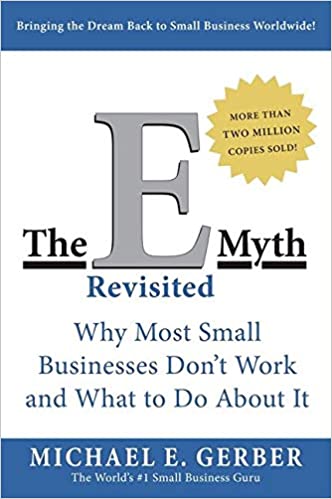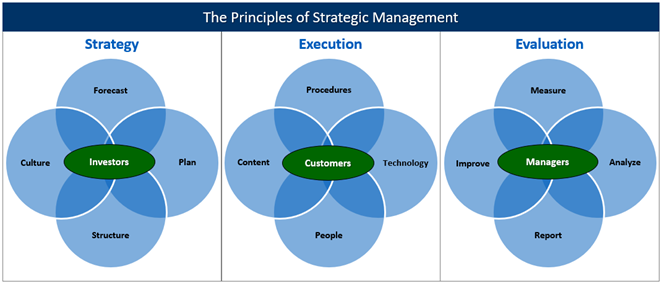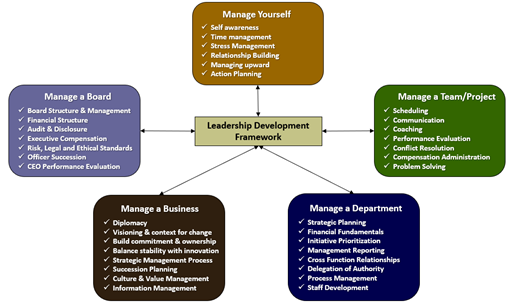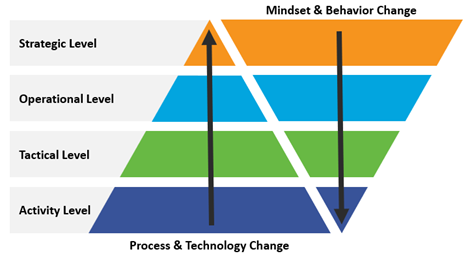Why most small businesses don’t work and what to do about it. This is the sub-title of Michael Gerber’s book The E-Myth. For nearly thirty-years, I have referred small business owners to “The E-Myth”. So, I decided to craft an executive summary with step-by-step instructions to help them implement Gerber’s concepts. Suffice it to say that most words, sentences, and concepts in this post are Gerber’s.
Click Here to complete an assessment of your businesses ability to sustainably grow and operate without you.
Meet The Small Business Owner
Let’s start by meeting The Small Business Owner. An image of a person standing alone, wind-blown against the elements comes to mind. A person bravely defying insurmountable odds. All in the pursuit of realizing the dream of creating a business of one’s own. An exciting, personally rewarding, and liberating small business.
Unfortunately, like Gerber, the small business owners that I’ve worked with experience exhaustion more than exhilaration. Their dream faded into a daily grind. Many are making a great living for their family. But are so overwhelmed they have no time or energy to enjoy what they’ve earned.
So, what were most small business owners doing before they launched their business? Technical work. And they were probably great at it. But they were doing it for somebody else. Then they experienced what Gerber describes as an Entrepreneurial Seizure that changed them for life. The thought of independence and making their own decisions seized their thoughts and actions.
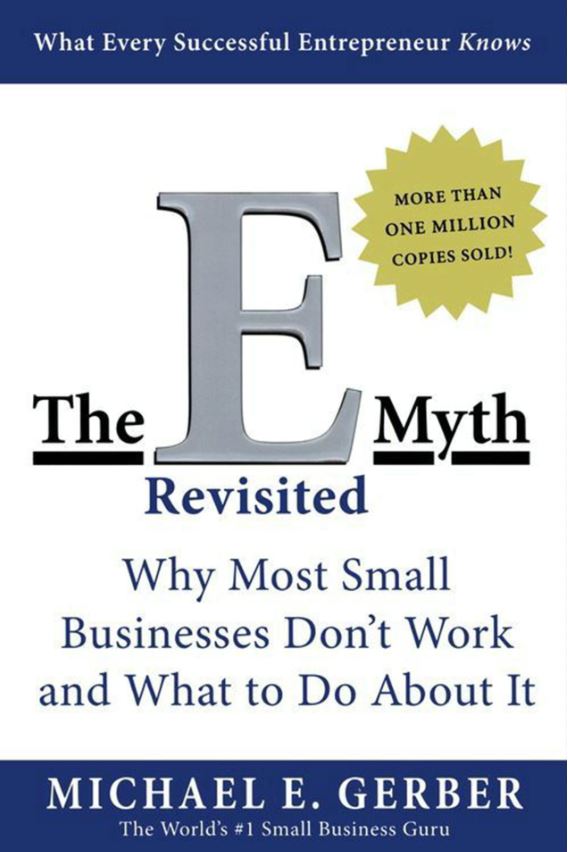
A Fatal Assumption
Many small business owners assume that if you understand the technical work, you understand how to run a business. This fatal assumption causes the small business owner to become enslaved rather than liberated. They put their heart and time into the technical work they love. They ignore the work required to run a business. Thus, becoming trapped in a cycle of doing work they love and begrudgingly the work they hate. Unfortunately, the work they hate is required to sustainably grow a business.
This cycle sucks the life out of them and causes their dream to turn into a nightmare. Think of it this way. If you didn’t know the technical work when starting a business, you could hire people that did. This would free you to manage the business. But the opposite is the reality for many people that start their own company.
Gerber’s Summary of The Small Business Situation:
Belief #1 – Small businesses don’t work, but the people that own them do.
Belief #2 – Small business owners work far more than they should for the return that they’re getting.
Belief #3 – Small business owners are working too hard – – on the wrong things.
Belief #4 – Most small businesses end up in chaos – – unmanageable, unpredictable, and unrewarding.
Belief #5 – The real reasons people start businesses have little to do with entrepreneurship and making profits.
The Truth About Being A Small Business Owner
To achieve success, small business owners must be three people in one: The Entrepreneur, The Manager, and The Technician. Each wants to be the boss; none wants to have a boss. Gerber defines each this way:
- The Entrepreneur is a creative visionary that lives in the future. An innovator that creates new methods. A personality that creates a great deal of havoc, that is unsettling for those around them. To this personality, most people are problems that get in the way of their dream. Their boundary is a function of how many managers they can engage in the pursuit of their vision.
- The Manager is a pragmatic planner that lives in the past. They crave order, predictability, and control. They see problems and obstacles that block the status quo. A personality with a strong need to organize and control things. Their boundary is a function of how many technicians they can supervise.
- The Technician is a doer that lives in the present. Their credo is “if you want it done right, do it yourself.” They love to tinker – – putting things together and then taking them apart. They are suspicious of lofty ideas. Thinking simply gets in the way of getting things done. Everyone gets in the technician’s way. Their boundary is determined by how much work they can do.
In a perfect world, The Entrepreneur would lead the small business. They would be free to forge ahead into new areas of interest (60% of the time). The Manager would be solidifying the base of operations (30% of the time). The Technician would be doing the technical work (10% of the time). The business would grow, and everyone would be happy.
The Small Business Problem
Unfortunately, it’s an imperfect world where The Technician typically leads the small business. Many spend 5% of their time as The Entrepreneur, 5% as The Manager, and 90% as The Technician. The Technician turned owner is the root cause of most small business problems.
This internal battle between The Entrepreneur, Manager, and Technician can sabotage a small business. For most small business owners these personalities are not balanced. The strongest of their personalities creates a tyranny within that thwarts the others from being free. One part of them dreams about the future, one craves order, while the other dreams about the future. It’s exhausting!
If Your Business Depends On You Being The Technician, You Don’t Have A Business You Have A Job. The Probability That Your Job Will Eventually Consume Both You And Your Business Is High!
Revenue Growth Is Great For A Small Business – – Right?
Unfortunately, when The Technician runs the business, the opposite can be true. Revenue growth can cause operations to exceed their ability to manage the business. So, they hire people to help them. But those people have needs of their own. They need more direction than The Technician can provide.
For employees to help a small business owner they need to know:
- Where the business is going.
- Why they’re doing what they’re doing.
- What result they are striving for.
- How their accountabilities fit into the overall strategy.
- The standards they will be held to.
Without this information, employees can become confused, procrastinate, and make unintentional mistakes. This can cause the business to go into a tailspin which consumes The Technician. To prevent this, The Technician must stop leaving things up to chance, reduce the chaos, and seize strategic control.
Simply put, small business owners must shift from working in their business to working on their business.
Steps For Working On Your Small Business
I’ve found that most small business owners know they need to work on their business. But many lack knowledge of how to do this. They also perceive that working on their business will take precious time they don’t have. They need a framework with concrete steps to guide them.
The Principles of Strategic Management provide a reliable, time-tested framework with three elements:
- Strategy used by The Entrepreneur to define how their business creatively solves customer problems. The Technician uses it to innovate how customers interact with your business. The combination of the two establish a strong value proposition.
- Execution used by The Manager and Technician to provide employees with the details they need to do their job. To take actions that create order, standardization, and quality.
- Evaluation used by The Entrepreneur to measure everything that the business does. With-out numbers you cannot know where you are, let alone where you are going.
The key is to take small, methodical steps to developing a system-driven business. This will enable you to delegate responsibilities to people you hire in a controlled manner. As they say, “Rome wasn’t built in a day”. So, don’t put unnecessary pressure on yourself.
Element #1 – Strategy
Strategy defines why your company exists and where it’s going. It provides a compass for guiding decision making. A tool for communicating to managers, employees, vendors, and investors where you’re going.
There are four steps you can take to build your small business strategy. First, define your strategic intent and exit strategy. Second, define your market scope and size. Third, build an organization structure and write job descriptions. And fourth, establish your company culture.
Step 1 – Define Strategic Intent and Exit Strategy
Gerber highlights the need to write a clear statement about the Primary Aim of your business. What are you trying to achieve? What business problem(s) are you solving in the marketplace? What are you planning to do with your company when you achieve success?
- Document The Founder’s Purpose for establishing the business – – why did you start the business?
- Define your Core ideology which includes your core purpose and core values. Note that these can never be achieved – – they are a way of life – – not a goal.
- Establish your Envisioned Future which includes two things. First, your audacious goal. And second, a vivid description of what achieving the goal will look like. Note that this can be achieved. Once achieved you will need to set a new audacious goal, or your business will struggle.
- Set Revenue Goals for 5-yearst to define how big is your vision of your business is.
- Define your exit strategy – – are you going to sell your business? Or roll-up multiple small companies into a large company by executing a series of acquisitions? Or transition your business to your children? What is your end goal?
Recommend that you read Jim Collins “Built To Last”.
Step 2 – Scope and Size Your Target Market
Many small business owners skip this step. They launch into marketing and selling their offerings. Then realize the market for their offerings is not large enough to sustain their business. Or they attempt to serve all buyer personas which scatters their time and limited resources. The key is to focus on a niche where your offerings add the most value to buyers. Then methodically expand into new markets. Here are some questions to help you focus:
- What frustration does your offering alleviate for buyers?
- What industries and/or consumer buyer personas need what you’re offering?
- Are their enough companies and/or consumers in those buyer personas to make it worthwhile pursuing (market share)?
- Where are those companies geographically concentrated and located?
Without An Organization Chart Confusion, Discord, And Conflict Become The Order Of The Day
Step 3 – Focus Your Organization Structure
Start by thinking of yourself as a shareholder rather than an employee. Then build your organization chart for the size business you want to become not the size you are today. You should:
- Design teams around work activities (processes) not around individual people. Be system-driven, not hero-dependent.
- Write job descriptions for each position in your organization chart including the CEO, department heads, and individual contributors. Focus each on no more than five to eight measurable job responsibilities.
- Assign to each employee (and yourself) all the job descriptions they are responsible for. This acknowledges the reality that you and your employees are wearing multiple hats. It’s better to assign multiple job descriptions to one person than to customize a job description for them.
- Define how much time you want employees to spend working on each job description they are responsible for. This will avoid confusion and keep you aligned.
- Rank order the job descriptions from first to fill as the company grows to last to fill. Start with the positions you are not effective at that will have the biggest impact on revenue growth. These positions should be filled first as resources become available.
- Create a Position Contract for each job description. Each should list the results to be achieved, work activities accountable for, and standards to be evaluated on. Employees should sign them.
Step 4 – Manage Your Company Culture
Customers and stakeholders should sense that your business is a special place, created by special people doing what they love. Your core purpose and core values serve as your culture compass. Here are some steps to bring your company culture to life:
- Define behaviors that indicate you and your employees are living your company core values. Use three to five behaviors for each core value.
- Measure the degree to which you and your employees are living your company core values. Think of it this way. There is no need to have core values if you’re not going to measure them.
- Assess job candidates against the behaviors to ensure a good culture fit before hiring them.
- Align your compensation, rewards, and recognition to incent employees to live the behaviors.
- Proactively document your company history. This is an important part of honoring the good and bad times. It’s also a great place to honor your employees.
Element #2 – Execution
Execution defines how you and your employees will operate your business. A tool for communicating to managers, employees, vendors, and investors actions that will be taken to achieve your strategy.
There are three steps you can take to define how your small business strategy will be executed. First, document work procedures for each function/process. Second, align your management procedures to enable your employees. And third, develop yourself and future business leaders.
Execute Work Activities The Way You Expect Employees To.
If You Don’t Follow The Rules, Why Should Your Employees?
Step 1 – Create an Employee Playbook
To scale your small business, employees need to know how to execute work activities. Providing them with step-by-step instructions is the key. This enables ordinary people to do extraordinary things. It also enables your small business to be operated by people with the lowest possible skill level and cost. Thus, providing you with a large pool of potential, low-cost employees.
- Map work activities for serving each buyer persona across the customer life cycle.
- Prepare checklists or playbooks for group of work activities.
- Visualize those activities in a manner that enables employees to instantly access and navigate the instructions. I recommend using TheNaviGuide tool to enable your employees.
Step 2 – Create A Management Playbook
Managers need step-by-step instructions just like employees do. If you don’t provide them, managers will lead your employees their way rather than your way. Your management procedures should follow the employee life cycle including checklists for:
- Hiring
- Onboarding new employees.
- Performance management.
- Compensation, rewards, and recognition.
- Continuously training employees
Step 3 – Develop Yourself and Future Business Leaders
Think of it this way. Skilled trade people operate at three levels of expertise: apprentice, journeyperson, and expert. Through this lens small business owner’s skills vary within the three personalities:
- The Entrepreneur – most are apprentices that should spend time learning from an expert.
- The Manager – most are apprentices that should continuously expand their knowledge.
- The Technician – most are experts that should document their knowledge and teach others.
So, you need to development the knowledge and skills to operate your business. This includes managing yourself, a project, a team, a department, a business, and a board of directors. To promote from within, you must intentionally develop your employees and managers along the same path including:
- Assessing yourself and your employees against the leadership development framework.
- Facilitating career development plans that include reading, on the job experience, rotational assignments, training programs, certifications, etc.
- Coaching for yourself and your future leaders.
Element #3 – Evaluate
Evaluation defines how you and your employees will determine if your business is in or out of control. It serves as a foundation and guide for decision making. A tool for communicating to managers, employees, vendors, and investors the score of the game. It also pinpoints areas for improving effectiveness, efficiency, and predictability.
There are four steps you can take to evaluate your business. First, measure work activities and results. Second, analyze activities and results to determine if your business is in or out of control. Third, report measures and analysis to employees, managers, and board members. And fourth, define actions to continuously improve.
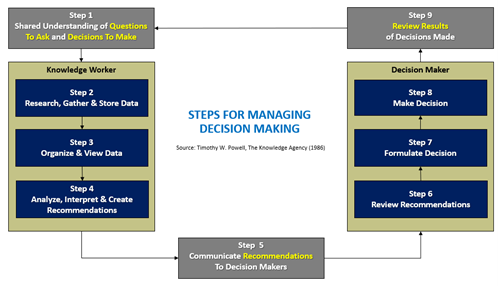
Step 1 – Measure
In simple terms, everything that your business does should be measured. With-out numbers it’s impossible to know where you are. Both quantitative and qualitative measures should be used to gauge effectiveness, efficiency, and predictability. Common units of measure include volume, cost, time, quality, and ratios.
There are four measurement levels: strategic, operating, tactical, and activity. I recommend using The Balanced Scorecard at the strategic level. Operational level metrics should include marketing, sales, product/service management, operations, supply chain, etc. It also should include shared services including human resources, accounting, information technology, legal, facilities, fleet, etc.
Step 2 – Analyze
Having a blizzard of metrics without organizing and analyzing them is a waste of time, money, and morale. Analysis should be completed on each element of your Balanced Scorecard at the strategic, operational, tactical, and activity levels. There are four types of analysis that provide insight into your business including:
- Retrospective (what happened)
- Diagnostic (why did it happen)
- Predictive (what will happen)
- Prescriptive (how to make it happen)
Finally, your analysis should anticipate second and third level questions. These occur after people review your first level analysis.
Step 3 – Report
Reports provide information to aid decision making. Decisions are made by employees, managers, and executives. Advice is provided by board members. So, reports should be produced to inform:
- Daily to inform employee activity level decisions.
- Weekly to inform manager tactical level decisions
- Monthly, quarterly, seasonally to inform executive operational and strategic decisions
Board members should receive quarterly, seasonal, and annual reports to inform the advice they provide the small business owner.
I recommend making all reports accessible to employees, managers, and executives. This level of transparency will inspire informed decision making at all levels. It will also build trust and unleash creativity.
This can be accomplished using Microsoft PowerBI as your primary analysis and reporting tool. PowerBI enables you to pull data fields from multiple disparate software systems into one platform. So, you can conduct different types of analysis i.e., gap, regression, factor, dispersion, discriminant, time series, etc. This will provide live-time access for employees, managers, executives, and board members.
Step 4 – Improve
At the end of the day, evaluation is about taking actions to improve effectiveness, efficiency, and predictability. Improvements should be made at the strategic, operational, task, and activity levels including:
- Prioritizing performance gaps
- Building action plans to close gaps
- Implementing improvement actions
- Tracking results of improvement actions
My recommendation is that improvement actions plans be managed through PowerBI. This will provide live-time access for employees, managers, executives, and board members.
In Conclusion
As you can see, launching and scaling a small business is complicated. I concur with Gerber’s advice that to seize control of your entrepreneurial dream you must:
- Address challenging issues through a reorganization of your thoughts as well as your business.
- Focus your attention on the multitude of seemingly insignificant, unimportant, and boring things that make up every business.
- Work on your business to prevent your dreams and business from becoming unmanageable, unpredictable, and unrewarding.
- Recognize that your business is nothing more than a distinct reflection of who you are. So, if your business is to change – as it must to continuously to thrive – – you much change first.
- Change your idea of what a business really is and what it takes to make one work.
Intentionally working on your business will enable your business to operate without you. This will free The Entrepreneur, Manager, and Technician inside you.
Please Take a Minute To:
- Write a comment on this post.
- Share this blog with other sales leaders, salespeople, CEO’s and investors.
It’s time to bring precision – – effectiveness, efficiency, and predictability – – to revenue growth.

